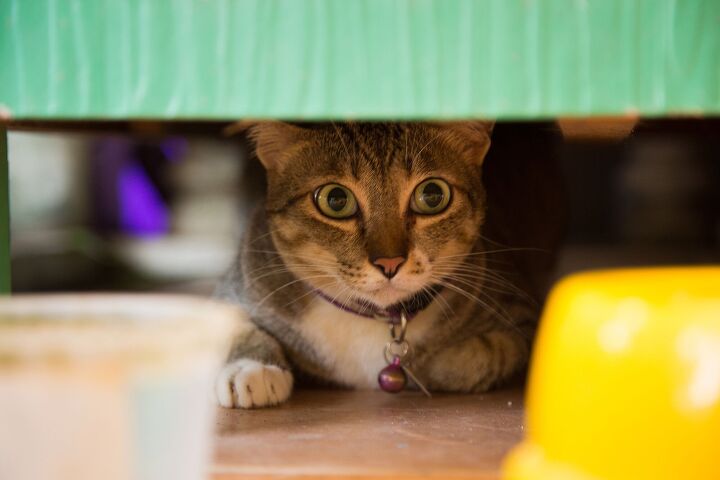How to Help a Shy Cat

Do you have a shy kitty who tends to hide a lot and doesn’t like being around people? Don’t worry, there are some things you can do to help them gain more confidence and feel more at ease.
When it comes to helping shy cats feel more comfortable, it’s all about working with them and taking a gentle approach, rather than trying to force them to be more outgoing. And it starts with understanding your furry friend and their needs and preferences.
Below is some information to help you get started, whether you recently adopted a shy kitty, you’re planning on bringing a new cat home and want to be prepared in case they’re super shy, or you’ve been living with a shy cat and want to help them become more social.
Give Your Cat Some Safe Spaces to Call Their Own
When cats want to be alone, perhaps because there are strange visitors in the house or they just want to relax, they may retreat to spaces like a closet, a hideaway like a tent or condo, or under the bed until they’re ready to come out. But you don’t want your cat to constantly hide and refuse to interact.
Set up little hiding places, like cat trees and covered beds, in areas of your home where your cat will be around people without being totally exposed. This might help them realize that they’re safe, and they can come out on their own time.
Providing new hiding spots in areas of your choosing while also blocking access to other spots, such as under the bed or behind the sofa, might be necessary to ensure your kitty won’t always hide where you can’t see or reach them.
A product like the K&H Self-Warming Kitty Bed Hooded might be a great choice for you and your cat, as you can unzip and remove the hood as your pet becomes less timid.
Blink Slowly, Speak in a Calm Voice, and Read Your Cat’s Body Language
Cats can tell you a lot about what they’re thinking and feeling if you know how to read their body language. And if you understand how felines communicate, you can use that to your advantage when working with an introverted kitty.
For example, if you look at your cat, blink slowly to let them know that you love them and they don’t need to be afraid of you. You can also use a soothing, calm voice to reassure them.
A noisy environment with loud voices, loud music, or a loud TV, is likely going to make a shy cat feel even more stressed, so in addition to changing the way you interact with your pet, ensure the environment they’re in also feels safe and serene.
Play with Your Cat and Give Them Treats
Encouraging your cat to play with you is another strategy to help them become less shy. You can also try this if you want to gradually get them to move into a more open space in the home, such as the living room.
You might be able to use a laser pointer or wand toy to entice them to come out of hiding. And these types of toys put you in control while also maintaining a comfortable distance for your timid kitty. Move the toy around in a way that will grab your feline’s attention and awaken their hunting instinct, as this might get them to come out surprisingly quickly.
During playtime, you can use treats to reward your cat when they’re able to catch the toy, as this can simulate a real hunt during which they’d take down prey. And you can also use treats in between play sessions to encourage your kitty to come out and spend time with you.
Give different toys a try to see what your cat is interested in most. You might start with a wand toy like SmartyKat Instincts Fly 'N Frenzy™ Extendable HappyNip® Wand Cat Toy, which features feathers, faux fur, raffia, ribbons, catnip, and silvervine and has a handle that extends to 24 inches.
Always Be Patient
No matter what, remain patient with your cat. Don’t force them to be in an open space without any places to hide, don’t forcibly remove them from their hiding spot, and don’t force them to be held or touched. Otherwise, you could end up causing them to feel more fearful and make them want to hide even more.
It can take quite a bit of time for a cat to realize that they can trust you, especially if they experienced things in the past that made them distrust people, so let them decide when they’re ready to take the next step.
Consult an Expert
It’s a good idea to consult an expert, such as a veterinarian or cat behaviorist, if you try out different strategies but don’t see progress or if your cat suddenly becomes reclusive – a change in your pet’s personality or behavior might indicate a health concern that needs to be addressed.
The right expert may be able to figure out what’s causing your cat to be so afraid and withdrawn, and they’ll be able to give you personalized guidance on what to change about your pet’s environment or daily routine to help them come out of their shell.
Finally, remember that some cats are always going to be shyer than others, and understand that every kitty is a unique individual with their own boundaries that need to be respected. Work with your cat, not against them.

Lisa Selvaggio is a freelance writer and editor, and our resident cats-pert, with certifications in pet nutrition and pet first aid. She enjoys producing content that helps people understand animals better so they can give their pets a safe and happy home.
More by Lisa Selvaggio

























